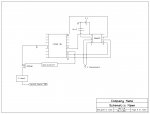Hello all!
I am trying to build a circuit that monitors the temperature of a filament in a high vacuum chamber with K thermocouple and simultaneously drive a high current source to that filament to heat it
according to the required temperature provided by the user. I thought just to continue this thread rather than making a new one. It would be greatly appreciated for any help or comment!
Here is my draft version of the project:

The PICAXE/MAX6675 interface was just copied from this forum. The currentsource is some old commercial high current power supply that we have at our institute so i don't have to meddle around with the mains.
The basic idea is to control the current into the filament with a pulse width control to drive the high power mosfet. I thought some optoisolation should be proper here, which is not yet implemented and the controlling system will just be some keypad/LCD system to control the required temperature and heating time (not yet implemented).
My question here is that, is this a proper way to do this? The actual temperature resolution is not that critical, 1 to 5 degree error is still ok. I would be satisfied with a maximum temperature of around 200 degrees,
but the better the higher it gets. Is there some issues with K thermocouples and high vacuum?
Thanks in advance,
Toni

